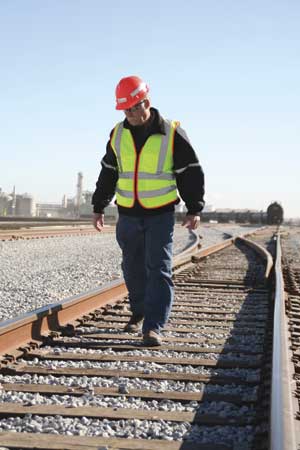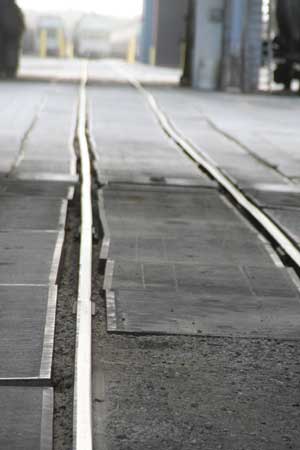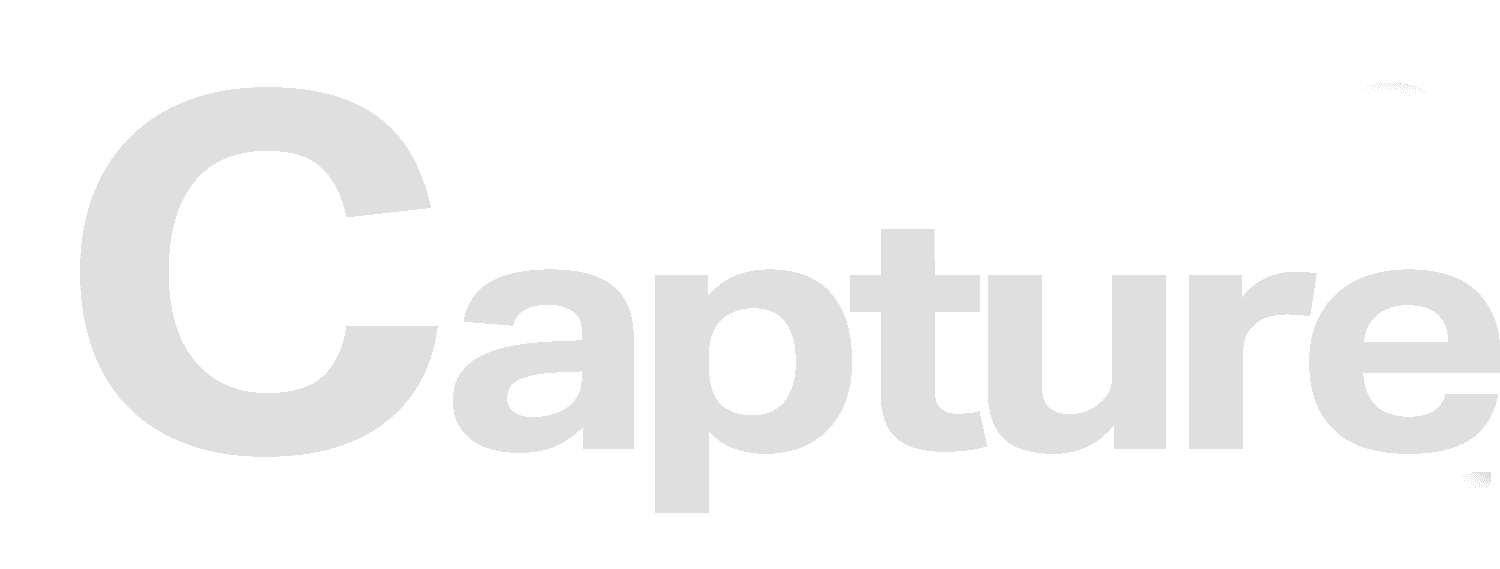The Fundamentals of Track Maintenance



February 11, 2008
BY Hal Harrison and Steve Kadrlik
More than 100 new biodiesel and ethanol facilities are expected to start production in the United States this decade. As the competitiveness within each industry grows, project owners spend considerable time and expense selecting the right property, preparing the site and constructing the facility. Yet, once the facility is in production, many owners will overlook protecting their multi-million dollar investment in railroad track infrastructure.
If properly maintained, railroad track will endure into the next century and generate a handsome return on investment. If neglected, the track will deteriorate, exposing owners to thousands of dollars in lost productivity and revenues, safety incidents and excessive track rehabilitation costs.
Even for facilities less than two years old, it's not too early to initiate a track maintenance program to safeguard the investment and ensure plant operations are not interrupted due to track failure.
Track maintenance doesn't require a significant time or financial investment. Much like there's no need to call in a professional to fuel and wash your car, or put air in the tires, the same applies for an ethanol facility's railroad track. Basic track housekeeping can be performed by a facility management team as part of a routine maintenance regimen.
Initial track maintenance is simple, but occasionally overlooked. The main objective is to keep the track free from any type of obstruction. Clean up feedstock and other materials that may have spilled from a railcar. Apply a herbicide or cut down vegetation that may have begun growing within and around the track. During the winter months, remove snow and ice from the track and switch points. A proactive and ongoing housekeeping program that pays attention to these areas will extend rail life and help make train movements more fluid throughout the facility.
Plant managers who wait to take action until others report track problems are taking a costly risk. Plant personnel can't count on railroads to alert them to track defects. The practice of railroads conducting routine industrial track inspections is a thing of the past. Railroad inspectors generally examine track only when they suspect a defect or safety concern. If inspectors find a serious defect, the railroad will not hesitate to "red flag" or discontinue service until repairs are completed.
Industry train crews are credited with reporting many track failures. However, a plant manager is already behind when a train crew member reports a "dip or kink, or the track is way out of cross level."
Taking a preventive approach will be less costly in the long run, eliminate safety risks and avoid a track outage. That begins by relying on a qualified track contractor to conduct semi-annual inspections, generally in the fall and spring, or before and after winter takes its toll on the track.
A thorough inspection involves walking the entire track, evaluating the subgrade, rail, ties, ballast, switches and turnouts. The inspection team will also often perform routine maintenance, such as adjusting switches and tightening bolts. If a pressing deficiency is identified, the contractor will notify the facility manager so immediate action can be taken. A few days after the inspection, the contractor will present a detailed report featuring an overall track evaluation and an assessment of each turnout in the facility.
Even though the track design and scope vary from facility to facility, new biodiesel startups will be confronted with similar track infrastructure concerns a few years into production. One of the most common problem areas is ballasted "approach track" set on the subgrade. This track adjoins direct fixation track in structures, which is set on concrete and generally located near the track scale. Track is only as good as the surface it is built upon. If the subgrade is inadequate, the approach track may show signs of settling as early as one year into use. A qualified track contractor can repair this problem by using a tamper to raise the elevation of the track, and tamping and re-ballasting the subgrade.
Another common problem area is water drainage, particularly at facilities that have expanded production capacity since opening. The addition of a new road or structure on the property can impact how water collects and drains. When water doesn't drain properly, it can erode the track subgrade, creating dips or uneven elevation. Again, the remedy calls for correcting the drainage problem and resurfacing-or tamping-the track to achieve the proper elevation.
Resurfacing costs vary based on the track profile, length and if any additional ballast is needed. Spot surfacing to correct low spots in approach tracks, isolated dips on the track and minor cross-level corrections may cost as much as $4,000 to $5,000. Resurfacing the entire track structure is more costly, with an average cost of $2 per foot and $1,200 per turnout.
The popular expression "Pay me now or pay me later" rings true when it comes to longer-term track maintenance. Spreading out a track maintenance investment over 15 years will put one ahead compared to putting off the expense until a severe problem arises. Well-maintained track will extend the life of the track and track components and save maintenance dollars in the long run.
Neglected track requires emergency repairs and more extensive rehabilitation. Without maintenance, track components such as ties, rail, ballast and switches will fail prematurely and require replacement years sooner than necessary. Wood ties with a life of 25 to 30 years will deteriorate years earlier. The same goes for rail, which if neglected will break down rather than last indefinitely.
Private industry can take a lesson from well-traveled railroads. Invest in properly maintaining a track network and it will keep a business free from safety incidents and profitable for generations to come.
Project Manager/Estimator Hal Harrison and Area Manager Steve Kadrlik work in the Lakeville, Minn., office of RailWorks Track Systems, a leading North American track contractor. Reach Harrison at hharrison@railworks.com. Reach Kadrlik at skadrlik@railworks.com. Both can be reached at (952) 469-4907.
If properly maintained, railroad track will endure into the next century and generate a handsome return on investment. If neglected, the track will deteriorate, exposing owners to thousands of dollars in lost productivity and revenues, safety incidents and excessive track rehabilitation costs.
Even for facilities less than two years old, it's not too early to initiate a track maintenance program to safeguard the investment and ensure plant operations are not interrupted due to track failure.
Track maintenance doesn't require a significant time or financial investment. Much like there's no need to call in a professional to fuel and wash your car, or put air in the tires, the same applies for an ethanol facility's railroad track. Basic track housekeeping can be performed by a facility management team as part of a routine maintenance regimen.
Initial track maintenance is simple, but occasionally overlooked. The main objective is to keep the track free from any type of obstruction. Clean up feedstock and other materials that may have spilled from a railcar. Apply a herbicide or cut down vegetation that may have begun growing within and around the track. During the winter months, remove snow and ice from the track and switch points. A proactive and ongoing housekeeping program that pays attention to these areas will extend rail life and help make train movements more fluid throughout the facility.
Plant managers who wait to take action until others report track problems are taking a costly risk. Plant personnel can't count on railroads to alert them to track defects. The practice of railroads conducting routine industrial track inspections is a thing of the past. Railroad inspectors generally examine track only when they suspect a defect or safety concern. If inspectors find a serious defect, the railroad will not hesitate to "red flag" or discontinue service until repairs are completed.
Industry train crews are credited with reporting many track failures. However, a plant manager is already behind when a train crew member reports a "dip or kink, or the track is way out of cross level."
Taking a preventive approach will be less costly in the long run, eliminate safety risks and avoid a track outage. That begins by relying on a qualified track contractor to conduct semi-annual inspections, generally in the fall and spring, or before and after winter takes its toll on the track.
A thorough inspection involves walking the entire track, evaluating the subgrade, rail, ties, ballast, switches and turnouts. The inspection team will also often perform routine maintenance, such as adjusting switches and tightening bolts. If a pressing deficiency is identified, the contractor will notify the facility manager so immediate action can be taken. A few days after the inspection, the contractor will present a detailed report featuring an overall track evaluation and an assessment of each turnout in the facility.
Even though the track design and scope vary from facility to facility, new biodiesel startups will be confronted with similar track infrastructure concerns a few years into production. One of the most common problem areas is ballasted "approach track" set on the subgrade. This track adjoins direct fixation track in structures, which is set on concrete and generally located near the track scale. Track is only as good as the surface it is built upon. If the subgrade is inadequate, the approach track may show signs of settling as early as one year into use. A qualified track contractor can repair this problem by using a tamper to raise the elevation of the track, and tamping and re-ballasting the subgrade.
Another common problem area is water drainage, particularly at facilities that have expanded production capacity since opening. The addition of a new road or structure on the property can impact how water collects and drains. When water doesn't drain properly, it can erode the track subgrade, creating dips or uneven elevation. Again, the remedy calls for correcting the drainage problem and resurfacing-or tamping-the track to achieve the proper elevation.
Resurfacing costs vary based on the track profile, length and if any additional ballast is needed. Spot surfacing to correct low spots in approach tracks, isolated dips on the track and minor cross-level corrections may cost as much as $4,000 to $5,000. Resurfacing the entire track structure is more costly, with an average cost of $2 per foot and $1,200 per turnout.
The popular expression "Pay me now or pay me later" rings true when it comes to longer-term track maintenance. Spreading out a track maintenance investment over 15 years will put one ahead compared to putting off the expense until a severe problem arises. Well-maintained track will extend the life of the track and track components and save maintenance dollars in the long run.
Neglected track requires emergency repairs and more extensive rehabilitation. Without maintenance, track components such as ties, rail, ballast and switches will fail prematurely and require replacement years sooner than necessary. Wood ties with a life of 25 to 30 years will deteriorate years earlier. The same goes for rail, which if neglected will break down rather than last indefinitely.
Private industry can take a lesson from well-traveled railroads. Invest in properly maintaining a track network and it will keep a business free from safety incidents and profitable for generations to come.
Project Manager/Estimator Hal Harrison and Area Manager Steve Kadrlik work in the Lakeville, Minn., office of RailWorks Track Systems, a leading North American track contractor. Reach Harrison at hharrison@railworks.com. Reach Kadrlik at skadrlik@railworks.com. Both can be reached at (952) 469-4907.
Advertisement
Advertisement
Upcoming Events





